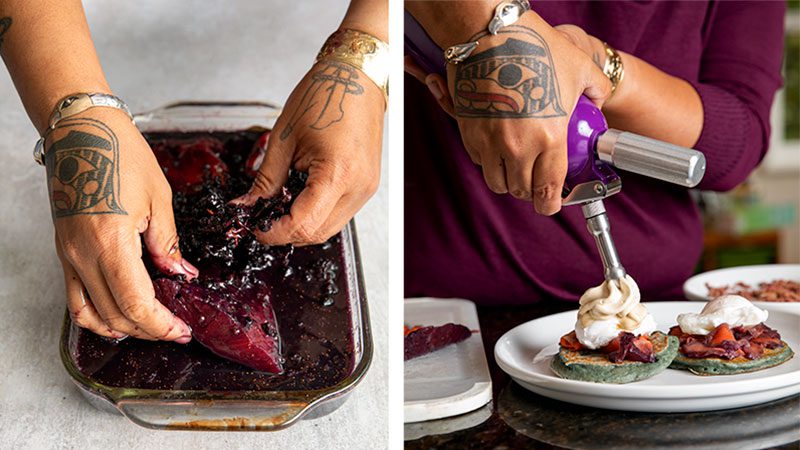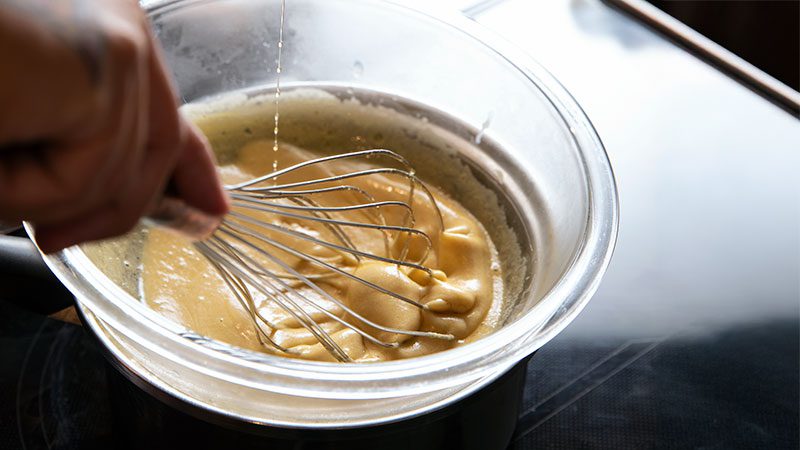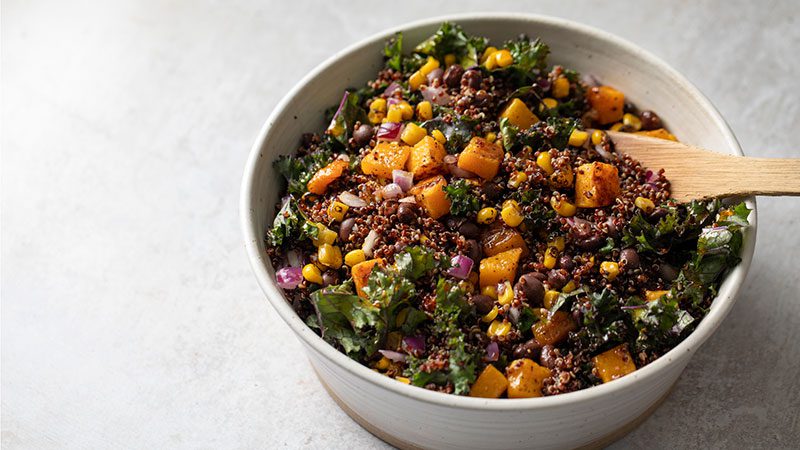Nikki Demmert’s recipe collection
All photos by Charity Burggraaf

Chef Nikki Demmert, current director of operations for United Indians of All Tribes Foundation, spoke recently with Sound Consumer about her connections with family, community and food. (See our conversation here.)
Demmert shared both recipes and philosophy while creating the “rematriated” take on eggs Benedict below. For that dish, she served her salal-cured salmon, a three-day process to create, with sumac hollandaise over blue corn pancakes and poached eggs. The cured salmon is also a beautiful accompaniment to bagels and cream cheese, or can star as the centerpiece on a charcuterie plate. The Three Sisters Salad can stand on its own as a main dish or a side, and is perfect for family and community gatherings.

Salal-cured Salmon
4 cups of salal berries, stems and pulp ok
1 cup salt
1 cup sugar
2 tablespoons cracked pepper
3 tablespoons fresh rosemary, minced
1 fillet of sashimi grade or previously frozen wild salmon, preferably sockeye or steelhead
Start by pin boning and drying your fillet, then set the boned fillet aside on a drying rack.
In a sauce pot simmer the salal berry in 1 cup of water, this is just to start the maceration process. Once the berries are juicing and releasing their beautiful color you can add pepper and rosemary. It’s OK to mash the berries and spices a bit to bring out as much color and flavor as possible. Once the liquid is cooled a bit mix in the salt and sugar. Transfer to a container and refrigerate until the mixture is completely cool.
Once the brine is cool, place your dry salmon fillet in the container, covering it with the brine. It’s OK to include all the pulp, stems and tough bits. It’s important to cover the whole surface of the fillet with the brine, on both sides. At this point you can either wrap the fillet tightly in plastic wrap or vacuum-seal the coated fillet in a vacuum sealer bag. If using plastic wrap I suggest that you flip the fillet over every day it is in the brine, for even curing in the refrigerator.
On the third day you can unveil your fillet: Scrape off the remaining bits of pulp and spice and rinse thoroughly. Let the fillet dry uncovered in the refrigerator for a few hours. This will allow the fillet to become firm enough to slice. You want to slice the fillet against the grain and as thinly as possible.

Blue Corn Pancakes
Makes 18-20 medium pancakes
4 cups blue corn masa
1 cup all-purpose flour
3 tablespoons baking powder
1 teaspoon salt
1 tablespoon sugar
½ cup butter, melted
2 eggs
2 cups milk
2 cups lukewarm water (more or less as needed, depending on masa)
This is made with the “dump method”—dump all ingredients in a large bowl and mix together. Depending on the type of masa you use you may need to adjust the water to your liking. I suggest letting your batter stand for at least 30 min before pan frying to allow the cornmeal to absorb liquids. The batter should be thicker than standard pancake batter, but still pourable.
Heat a lightly greased skillet or griddle over medium heat.
Pour about ¼ cup of batter per pancake onto the skillet. Cook until bubbles form on the surface and the edges look set, 2–3 minutes. Flip and cook another 1–2 minutes until golden and cooked through.

Sumac Hollandaise
For the gastrique:
½ shallot, chopped
One slice lemon, including zest
1 cup white wine
½ cup sumac seeds
Cracked black pepper
Combine all gastrique ingredients in a small saucepan. Bring to a simmer and cook until the liquid reduces by half, stirring occasionally. Strain through a fine-mesh sieve or cheesecloth and let cool.
For the hollandaise:
4 egg yolks
Juice of one lemon
¼ teaspoon salt
1 cup hot melted butter or ghee (the temperature should not be above around 150 degrees F, you don’t want to scramble the eggs)
Place the yolks and salt in a food processor and pulse a few times to start aerating them. Then add the cooled gastrique. Pulse a few more times to incorporate.
While holding the pulse button, stream in the hot melted butter. The sauce should emulsify and become velvety. If it gets too stiff carefully add in warm water, a teaspoon at a time.

Three Sisters Quinoa Salad
Makes 8-10 servings as a side dish
For the Maple Vinaigrette:
½ cup cider vinegar
½ cup maple syrup
2 cups grapeseed oil
2 tablespoons smoked paprika
1 tablespoon cracked pepper
1 tablespoon kosher salt
For the Salad:
4 cups cooked quinoa
1 cup canned black beans. rinsed
1 cup frozen roasted corn kernels
2 cups butternut squash, cubed
½ cup diced red onion
2 cups chopped kale
Preheat oven to 400 degrees F.
To make the dressing, you can put all the components in a blender and set it to whiz and stop it when the Creator says enough is enough. Or, you can put them all in a bowl and whisk together with a fork—or put them in a jar and shake it.
As for the salad, the most important flavor components are roasted corn and the butternut squash. Put the squash in a bowl and toss with oil and salt and pepper. Place it on a baking sheet and bake in the preheated oven until the squash is fully cooked and lightly browned, generally 25-30 minutes. In the last few minutes of cooking the squash, add the corn just to heat through.
Place the squash and corn in a bowl to cool.
Combine all salad ingredients in a large bowl, tossing thoroughly to be sure the colors and textures are distributed evenly. Add the desired amount of dressing and let stand in the refrigerator until chill.
This salad is perfect for any barbeque, side dish, or moment to give gratitude to the teachings of reciprocity the plants give us.
